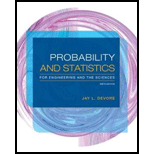
Concept explainers
Consider a 3-sigma control chart with a center line at µ0 and based on n = 5. Assuming normality, calculate the
a. µ0 + .5σ
b. µ0 − σ
c. µ0 + 2σ
a.
Find the probability that a single point will fall outside the control limits when the actual process mean is
Answer to Problem 7E
The probability that a single point will fall outside the control limits when the actual process mean is
Explanation of Solution
Given info:
Consider, a 3-sigma control chart based on center line
Calculation:
It is known that for a 3-sigma chart the probability that a single point will fall outside the control limits when the actual process mean is
It is known that, for a random variable X that follows normal distribution with mean
Thus,
Now, for
According to table A.3, “Standard Normal Curve Areas” of Appendix the standard normal variable value for
Thus,
Thus, the probability that a single point will fall outside the control limits when the actual process mean is
b.
Find the probability that a single point will fall outside the control limits when the actual process mean is
Answer to Problem 7E
The probability that a single point will fall outside the control limits when the actual process mean is
Explanation of Solution
Calculation:
It is known that for a 3-sigma chart the probability that a single point will fall outside the control limits when the actual process mean is
It is known that, for a random variable X that follows normal distribution with mean
Thus,
Now, for
According to table A.3, “Standard Normal Curve Areas” of Appendix the standard normal variable value for
Thus,
Thus, the probability that a single point will fall outside the control limits when the actual process mean is
c.
Find the probability that a single point will fall outside the control limits when the actual process mean is
Answer to Problem 7E
The probability that a single point will fall outside the control limits when the actual process mean is
Explanation of Solution
Calculation:
It is known that for a 3-sigma chart the probability that a single point will fall outside the control limits when the actual process mean is
It is known that, for a random variable X that follows normal distribution with mean
Thus,
Now, for
According to table A.3, “Standard Normal Curve Areas” of Appendix the standard normal variable value for
Thus,
Thus, the probability that a single point will fall outside the control limits when the actual process mean is
Want to see more full solutions like this?
Chapter 16 Solutions
Probability and Statistics for Engineering and the Sciences
- Suppose that you take a sample of 100 from a population that contains 45 percent Democrats. What sample size condition do you need to check here (if any)?What’s the standard error of ^P?Compare the standard errors of ^p n=100 for ,n=1000 , n=10,000, and comment.arrow_forwardSuppose that a class’s test scores have a mean of 80 and standard deviation of 5. You choose 25 students from the class. What’s the chance that the group’s average test score is more than 82?arrow_forwardSuppose that you collect data on 10 products and check their weights. The average should be 10 ounces, but your sample mean is 9 ounces with standard deviation 2 ounces. Find the standard score.What percentile is the standard score found in part a of this question closest to?Suppose that the mean really is 10 ounces. Do you find these results unusual? Use probabilities to explain.arrow_forward
- Suppose that you want to sample expensive computer chips, but you can have only n=3 of them. Should you continue the experiment?arrow_forwardSuppose that studies claim that 40 percent of cellphone owners use their phones in the car while driving. What’s the chance that more than 425 out of a random sample of 1,000 cellphone owners say they use their phones while driving?arrow_forwardSuppose that the average length of stay in Europe for American tourists is 17 days, with standard deviation 4.5. You choose a random sample of 16 American tourists. The sample of 16 stay an average of 18.5 days or more. What’s the chance of that happening?arrow_forward
- How do you recognize that a statistical problem requires you to use the CLT? Think of one or two clues you can look for. (Assume quantitative data.)arrow_forwardSuppose that you take a sample of 100 from a skewed population with mean 50 and standard deviation 15. What sample size condition do you need to check here (if any)?What’s the shape and center of the sampling distribution for ?What’s the standard error?arrow_forwardQuestion 3 The following stem-and-leaf displays the weekly salary of employees at this firm. Stem-and-Leaf Display Leaf Unit = 10.0 N=x 5 3 00123 12 4 0125888 (y) 5 11234456777 z 6 13568 5 7 154 2 8 46 i. Determine the value of x, y and z. [3] ii. What is the value of the median? [2] iii. Find the mode of this data set. iv. Calculate the range [1] [2]arrow_forward
- Let Y be a continuous RV with PDF otherwise Find the CDF, Fry), of Y . Find an expression for pth, p € (0, 1), quantile of the distribution. Find E(Y) and V(Y). Find E(-2Y + 1) and V(-3Y - 2). Find E(Y3).arrow_forwardLet X be a continuous RV with CDF Find P(X < 0), P(-1 < X < 1) and P(0.5 < X). Based on your answers to the above questions, what is the median of the distribu-tion? Why Find the PDF, fx (x), of X.arrow_forwardA survey of 581 citizens found that 313 of them favor a new bill introduced by the city. We want to find a 95% confidence interval for the true proportion of the population who favor the bill. What is the lower limit of the interval? Enter the result as a decimal rounded to 3 decimal digits. Your Answer:arrow_forward
 Glencoe Algebra 1, Student Edition, 9780079039897...AlgebraISBN:9780079039897Author:CarterPublisher:McGraw Hill
Glencoe Algebra 1, Student Edition, 9780079039897...AlgebraISBN:9780079039897Author:CarterPublisher:McGraw Hill

